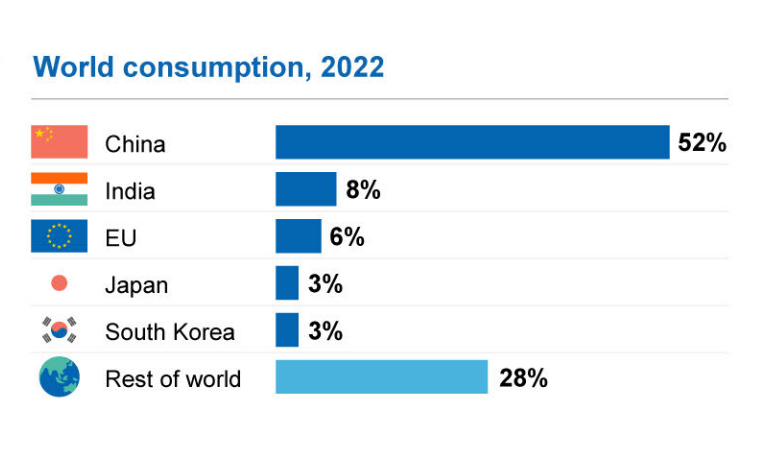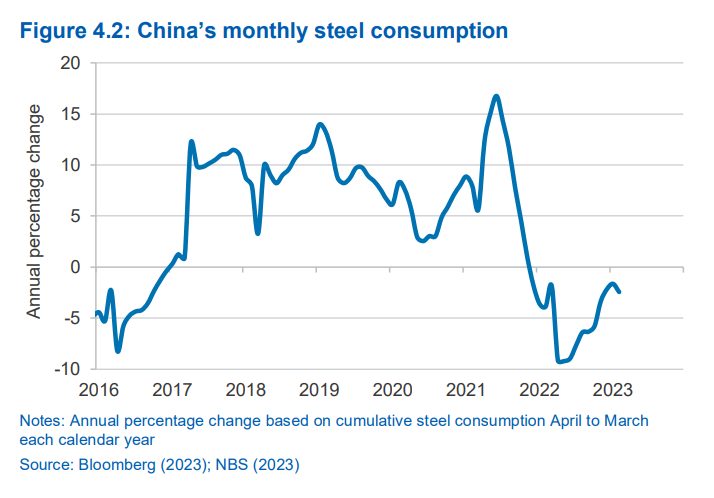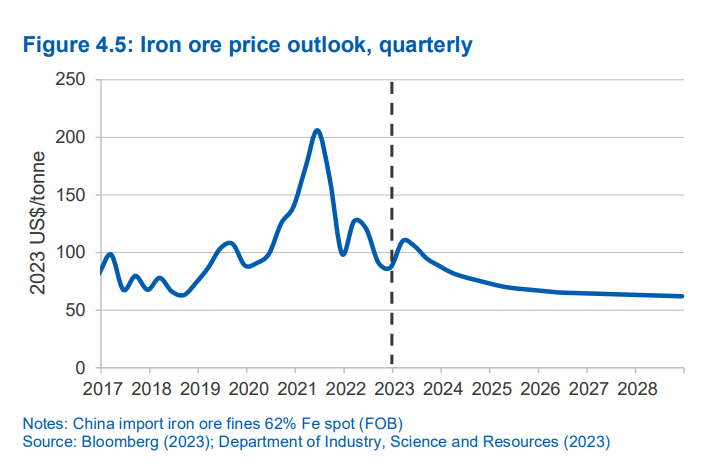Is this as good as it gets for iron ore?
With reasonable regularity over the past five years, pundits have been calling the end of the iron ore boom for Australia.
The top was called in 2017, 2021, 2022, March this year and as recently as a couple of days ago. But to steal (and butcher) a line from Mark Twain, reports of iron ore’s death have been greatly exaggerated… so far at least.
So have things materially changed for iron ore - and is this time truly different?
To answer the question in the affirmative flies in the face of commentary around a commodities supercycle. But it’s very possible that iron ore, as a more traditional commodity, will taper off just as other commodities (think lithium and battery metals) really start to ramp up.
The latest argument roughly posits that China’s massive, 20-year construction boom is coming to an end. Having modernised quickly and built vast amounts of housing and infrastructure to support its population, China simply won’t need as much iron ore as it has in the past two decades moving forward.
It’s a compelling argument, made even more alarming when considering China currently accounts for more than half of world consumption.

The following graphic also shows the marked slowdown in China’s monthly steel consumption between 2021 and 2022, with consumption also starting to roll over again more recently.

All the graphics aside, the Australian government’s own forecasting (from the Office of the Chief Economist) is calling for slowing demand, more supply, and lower prices in coming years.
“China faces several key structural drivers that are expected to contribute to this lower demand growth".
"The foremost of these is China’s stated aim to reach peak steel output by 2030, with the country expected to achieve this within the next few years. As well as contributing to the country’s net zero emissions ambition, China’s efforts to reduce aggregate steel output are expected to support a longer-term shift in its economy away from investment-led (and toward consumption-led) growth”.
The report also adds that “with the real estate sector constituting as much as 25% of the Chinese economy, weakness in the country’s property sector will continue to diminish the country’s near-term steel demand. This is expected to see China’s iron ore demand decline by around 1% annually over the outlook period to 2028”.
How big could the China hole be?
The estimates in the government report above are considered by some to be extremely conservative.
There are some estimates that the slowing of the construction sector in China will lead to a decrease of 100-200 million tonnes of steel demand. That equates to around 160-320 million tonnes of iron ore. Source: (VIEW LINK)
To put all of that in perspective, China’s main supplier of iron ore (Australia) fulfilled 70% of the red dragon’s demand and produced 880 million tonnes of usable iron ore last year.
For further perspective, Fortescue Metals estimates that FY23 shipments will total between 187-192 million tonnes.
Is there any good news?
Yes, some. The same government report suggests that growing steel demand and production capacity in regions such as emerging Asia and the Middle East are projected to see strong growth in ex-China iron ore consumption over the period.
More than 100 million tonnes of steelmaking capacity is expected to be brought online in the next few years in Asia alone, which could see ex-China demand for iron ore rise by 3.2% per annum.
But, it won’t be enough.
When it comes to supply, Australia and Brazil are expected to grow export volumes by that same 3.2% per annum over the period, whilst new supply from emerging producers in Africa will also come online.
What does this mean for the iron ore price?

It doesn’t look good, as the graphic above shows.
From an estimated average price of around US$100 per tonne in 2023, the benchmark iron ore price is projected to average around US$63 per tonne (in real terms) by 2028.
What is happening now?
Whilst 2028 is a long time away, things can change quickly, and there is likely to be new demand sources for steel and iron ore as the world transitions its energy supply, there is potentially still money to be made now.
Whilst iron ore prices are widely expected to come down, the big players (BHP, RIO and FMG) are still profitable at much lower prices than what we're seeing at present. BHP's breakeven price is reported to be US$45 per tonne, RIO's reportedly US$39 per tonne, and FMG's reportedly US$64 per tonne.
In a recent note from Macquarie, the broker noted that “sentiment in the iron ore market was improving, despite muted demand”.
“Market sentiment improved … on talk of a central government stimulus package in China. Blast Furnace steel output climbed for the second week, while steel margins remained negative last week”.
In terms of exposure BHP Group (ASX: BHP) remains the preferred large-cap exposure “as the company boasts stronger organic growth options”.
Macquarie also has a positive view on Mineral Resources (ASX: MIN), but that is less about the company’s iron ore exposure and more about its exposure to lithium. Of other names in the space, Macquarie notes "Deterra Royalties (ASX: DRR) offers low volatility exposure to iron ore, while Champion Iron (ASX: CIA) offers high-grade exposure via Bloom Lake and Direct”.
China’s state iron ore buyer – China Mineral Resource Group (CMRG)
Late last year, China set up a centralised buying function for iron ore miners.
The goal is for CMRG to become the sole Chinese channel for buying imported iron ore from third parties across the globe, by assuming broad responsibility for raw materials supplies to the country’s steel industry.
Much was written about it at the time and there were some concerns that the CMRG would wield incredible power and drive prices down sharply.
It hasn’t happened yet.
A note from Citi provided the following:
“China’s new state iron ore buyer is asserting itself in negotiating deals for the world’s biggest steel industry but has yet to help manufacturers struggling with weak demand to get lower prices, mills and miners said. Around 30 Chinese steel mills have signed 2023 iron ore procurement contracts through China Mineral Resources Group (CMRG),
“We have not received any cheaper iron ore prices and to be honest I don’t expect they can get better deals any time soon,” a purchasing manager from a state-owned Chinese steel mill said on the sidelines of an industry event in Singapore this week.”
So it seems that iron ore still has some life in it yet, although investors should be mindful of the long-term outlook and what it could mean for the share prices of Australia’s iron ore majors.
2 topics
4 stocks mentioned

